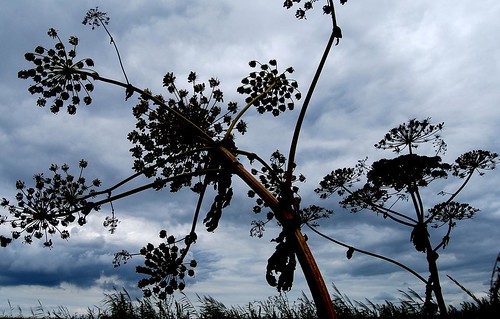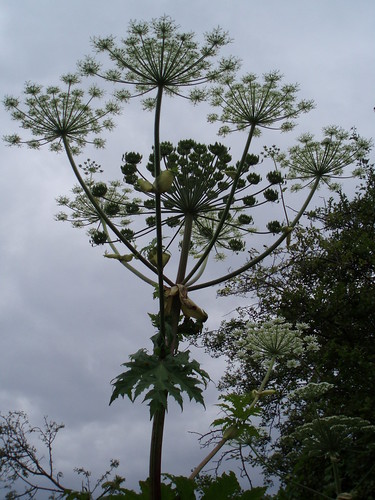Giant Hogweed (Heracleum mantegazzianum) by sillie_R
Most reports of giant hogweed turn out to be Cow Parsnip, Angelica, or some other [member of the carrot family]. See here. People can distinguish giant hogweed from other species of the carrot family, not only by its gargantuan size, but by its purple-splotched, hairy stems.
Giant Hogweed by Limbo Poet
“Cow parsnip stems have a more ‘furry’ look to them, whereas the hogweed has long, white hairs which are most pronounced at the base of the leaf petiole (stem). But the foliage of cow parsnips and giant hogweeds before they send up flower stalks is so similar it’s almost impossible to tell them apart.†This statement comes from the U.S. Department of Agriculture’s National Noxious Weed Program on Giant Hogweed, where you can get some bulletins with photos and information on Giant Hogweed.
Here’s another website that has a photo of the Giant Hogweed so that you can see if this is indeed the plant you wrtie about. It looks like a Queen Anne’s Lace flower on steroids because the plant can grow up to 20 feet with a flower that measures up to 3 ft across and leaves that can be 5 feet wide. Giant Hogweed
(Heracleum mantegazzianum) also called giant cow parsely is in the Apiaceae family.
Giant Hogweed is an invasive plant considered worst than poison ivy and poison oak because it can cause skin irritation- if the sap touches you during the sunlight you can get blisters that may require intravenous antibiotics or cortisone and it can cause either temporary or permanent blindness. Do NOT touch or let your dog touch Giant Hogweed. I have read of dogs getting something called photodermatitis from this plant and you can be affected if a cat or dog touches the plant and you touch the pet.
In many states where this plant is a problem, they have hotlines to contact. For example. Michigan’s hotline for this plant alone 800-292-3939 that you can call for advice.
Or you can contact your state’s Agricultural Extension.
If what you have is Giant Hogweed, you should contact your state’s Department of Environmental Conservation for the proper procedure of removing the plant.
You or your town have to do more than just cut Giant Hogweed down once a year because if the roots remain, you will be getting more of this problem plant the following year.
Whoever does the work will have to dress properly before touching the plant- that will mean disposable gloves, goggles, ski mask or face covering, hat, long sleeved shirt, long pants and shoes or boots.
Giant Hogweed spreads thousands of seeds, so if it is in flower, you will have to cut off the flower before it sets seeds by cutting it into a bag. If the seeds have already set, cut them so that they fall into a bag. Any seeds that escape can grow.
In the evening, cut the stalks at the base and try to dig up the roots- this might not be possible if the plants are large.Fortunately Giant Hogweed does not spread that rampantly UNLESS it is near waterways.
Apply a chemical called glyphosate to the roots or stems that remain. Glyphosate is sold under the brand names of Roundup, Rodeo and Pondmaster. Always read directions for proper usage because glyphosate can kill other plants and can get into the water. It is a chemical that kills and though still allowed to be used in the US, Denmark has banned it and even here scientists are finding concern about its use. So use any chemical with care.
When you call your department of Environmental Conservation, ask them how they want the plant disposed.
When finished working on getting rid of the plants, get rid of your disposable gloves and launder your clothing worn on the job. See here.



I am wondering, once I dig up the roots, can it be burned safely? Or if it is dug up and bagged, then what do I do with it?
Do not burn hogweed, unless it has had atleast 1 year to dry out, bag it and ask youur township about disposal. My backyard is infested. My children are no longer allowed to play in my huge backyard, and the town is not willing to help me remove it. Not impressed. My son was hospitalized last year bcs of the severity of his burns, and still has loss of feeling on his hand and arm. I have put sooo much time and $ into trying to rid my yard, but nothing seems to be working.